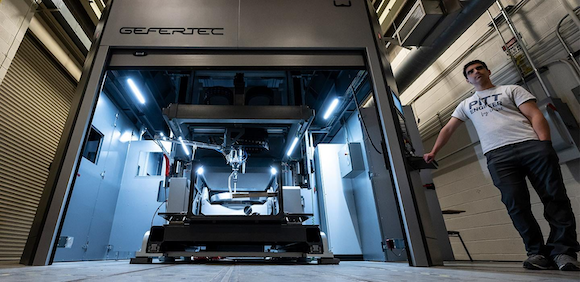University of Pittsburgh adds wire-based DED machine from Gefertec
August 16, 2022

The University of Pittsburgh, Pennsylvania, USA, has acquired a Directed Energy Deposition (DED) metal Additive Manufacturing machine from Gefertec GmbH, Berlin, Germany. The Gefertec arc605 machine, which uses a wire-based DED process (referred to by the company as Wire Arc Additive Manufacturing [WAAM]), is said to be the first of its kind to be used in a US-based university.
The wire-based DED machine is ideal for additively manufacturing larger parts that would normally have to be cast and tooled, an expensive approach that’s often not practical for manufacturing small-batch, speciality pieces. The university explains that previous metal AM machines that use Laser Beam Powder Bed Fusion (PBF-LB) are able to lay down a few hundred grams an hour, whereas the Gefertec arc605 are an order of magnitude faster.
Albert To, William Kepler Whiteford Professor in the Swanson School of Engineering, commented, “Even on the order of tens of parts, this is very advantageous. And if you want to include some complexity, then you can’t do it any other way than 3D printing.”
The AM machine’s advanced software and ‘five-axis’ capabilities – where pieces can be rotated and tilted during Additive Manufacturing – means it can be used to create complex metal parts. However, the University states that there are still challenges to work out. For instance, metals warp as they heat and cool, a process that To is using the new AM machine to study with funding from the U.S. Army and the Department of Energy.
Xavier Jimenez, a third-year PhD student in To’s lab, is developing a process to additively manufacture using a new type of high-strength aluminium that has potential applications in aerospace but tends to crack when welded.
“You have to tune all these different parameters to figure out what will produce the best-quality weld. Every material behaves a little differently,” stated Jimenez.
Jimenez explains that he came to the University of Pittsburgh in part because he wished to work with the Gefertec arc605, but this was impacted by COVID-19 which caused a three-year delay in the machine arriving at the university. The machine is so large that, on arrival, it had to be dropped into the lab piece-by-piece via crane and then assembled.
Now fully installed an operational, the university’s researchers are in the process of testing parameters for the Additive Manufacturing of different metals. By testing the approach for different metals, then using X-rays and testing material properties, they can start to model how the process affects a part — from visible warping to changes to the microscopic structure of the material.
Jimenez concluded, “It was a lot of work to get all the pieces together to get the machine working. We’re very happy that it’s here.”















